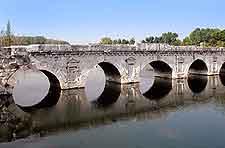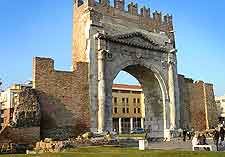Rimini History Facts and Timeline
(Rimini, Emilia-Romagna, Italy)

Rimini boasts a long and rich history. It was originally settled by the Greeks and then by the Gauls. By the 3rd century BC, however, the Romans had established a colony here. They set up roads and fortifications in the town, as well as many civic buildings.
It is known that Julius Caesar once visited the town, around the year of 50 BC, and delivered a speech here. Later, Emperor Augustus visited Rimini and, in 27 AD, an arch was built in his honour.
In the 6th century AD, Rimini became part of the Byzantine Empire. It didn't fare well under its new rulers. Indeed, the town's early history is punctuated by frequent changes of ruler and attacks by the Lombards, Normans, Franks and Swabians.
From Medieval to Renaissance Times
By the 13th century, Rimini was under the control of the Malatesta family. After centuries of political turmoil, their long-term domination brought much-needed stability to the town.
Between the years of 1437 and 1446, the Castel Sigismondo was built on the orders of Sigismondo Malatesta, who as well as being a city governor was also a patron of the arts. The power of this influential family began to wane during this century. By 1503, they had lost any remaining land in the town to the Venetians. Later, the town was to become a part of the Papal States.

History of Early Modern Times to the Present Day
Until the 18th century, Rimini suffered successive attacks by raiding armies and pirates, as well as natural disasters, which ranged from earthquakes to floods. Its economy was vastly weakened, and over time Rimini began to rely more and more on its fishing industry.
In the middle of the 19th century, Rimini's role changed completely, when it was reborn as a popular seaside resort. In 1843, the first bathing establishment was built. Then, in 1858, both the Grand Hotel and the Kursaal complex opened their doors to the public. The latter was designed to hold large social events and it quickly became a symbol of the town's success. In 1860, the people of Rimini voted in favour of becoming part of the Kingdom of Italy.
At the outbreak of World War I, Rimini found itself to be a prime target. It was also a divided town, with some wanting to remain neutral, whilst others favoured intervention. In World War II, the Battle of Rimini led to extensive damage. During the action that took place in 1944, most of the town was reduced to ruins. It was finally taken by the forces of Canada and Greece.
In the post-war period, Rimini began the massive reconstruction needed to transform itself into a leading tourist resort. It is particularly popular with Italian holiday makers.
 Rimini boasts a long and rich history. It was originally settled by the Greeks and then by the Gauls. By the 3rd century BC, however, the Romans had established a colony here. They set up roads and fortifications in the town, as well as many civic buildings.
Rimini boasts a long and rich history. It was originally settled by the Greeks and then by the Gauls. By the 3rd century BC, however, the Romans had established a colony here. They set up roads and fortifications in the town, as well as many civic buildings.